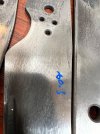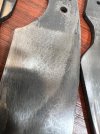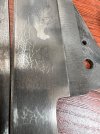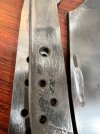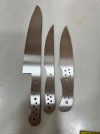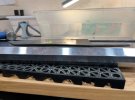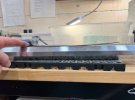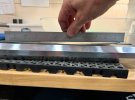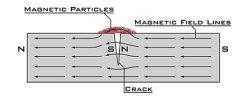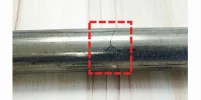- Joined
- Dec 9, 2003
- Messages
- 4,817
I am trying my hand at kitchen knives and today was not a good day, I lost 3 out of my 4 blades. Luckily 1/6" AEB-L is quite inexpensive! Please let me know if I screwed up, the heat treat screwed up, or its just the nature of the beast?
The blades were all 1/6th" AEB-L 8" chef size knives. Blades were profiled but no bevels ground. Knives were heat treated by a forum member who runs a heat treating business and has a good reputation from what I can tell. Knives were marked as being tested around 61.5 HRC +/-. Blades did have a bunch of very shallow circular and line dents which I think was part of the straightening process?
First Problem
1st blade I was grinding and I noticed it had some flex. I grabbed the tip and the handle and flexed it a bit, curious how flexible it would be. The tang (1/2" wide) snapped where it reached the blade despite not having put much muscle behind it. Knowing that AEB-L is a very tough steel I was very surprised it snapped that easily. Maybe at that hardness no steel flexes well? Certainly nothing like the 90 degree torture tests you see. I wondered if it was a bad heat treat? I took a broken piece of the blade which hadn't been beveled enough to have a rough edge and used a hammer to test the steel further. I hammered the blade through a 1/16" nail with no significant edge damage. I then hammered it on the edge of 1/4 plate steel and it really dug in, only chipping once despite many hits digging into the steel plate quite a bit. So now I am bot amazed at the toughness at the edge and at how easily it snapped.
Second Problem
While beveling 2 blades at about the 120 grit stage I noticed hairline cracks at the edge of the blade. I confirmed by flexing the blade just a little and could feel the crack with my finger nail. One blade had one crack almost a centimeter inwards, the other I noticed one on the edge and 3 on the spine. I know I didn't grind the blade too hot so I am wondering is this a heat treat problem, a steel supplier problem, or just the nature of steel at that thickness?
Thanks in advance!
Edited to add photos but they are from instagram stories so I don't know how long they will stay up.


The blades were all 1/6th" AEB-L 8" chef size knives. Blades were profiled but no bevels ground. Knives were heat treated by a forum member who runs a heat treating business and has a good reputation from what I can tell. Knives were marked as being tested around 61.5 HRC +/-. Blades did have a bunch of very shallow circular and line dents which I think was part of the straightening process?
First Problem
1st blade I was grinding and I noticed it had some flex. I grabbed the tip and the handle and flexed it a bit, curious how flexible it would be. The tang (1/2" wide) snapped where it reached the blade despite not having put much muscle behind it. Knowing that AEB-L is a very tough steel I was very surprised it snapped that easily. Maybe at that hardness no steel flexes well? Certainly nothing like the 90 degree torture tests you see. I wondered if it was a bad heat treat? I took a broken piece of the blade which hadn't been beveled enough to have a rough edge and used a hammer to test the steel further. I hammered the blade through a 1/16" nail with no significant edge damage. I then hammered it on the edge of 1/4 plate steel and it really dug in, only chipping once despite many hits digging into the steel plate quite a bit. So now I am bot amazed at the toughness at the edge and at how easily it snapped.
Second Problem
While beveling 2 blades at about the 120 grit stage I noticed hairline cracks at the edge of the blade. I confirmed by flexing the blade just a little and could feel the crack with my finger nail. One blade had one crack almost a centimeter inwards, the other I noticed one on the edge and 3 on the spine. I know I didn't grind the blade too hot so I am wondering is this a heat treat problem, a steel supplier problem, or just the nature of steel at that thickness?
Thanks in advance!
Edited to add photos but they are from instagram stories so I don't know how long they will stay up.


Last edited:

